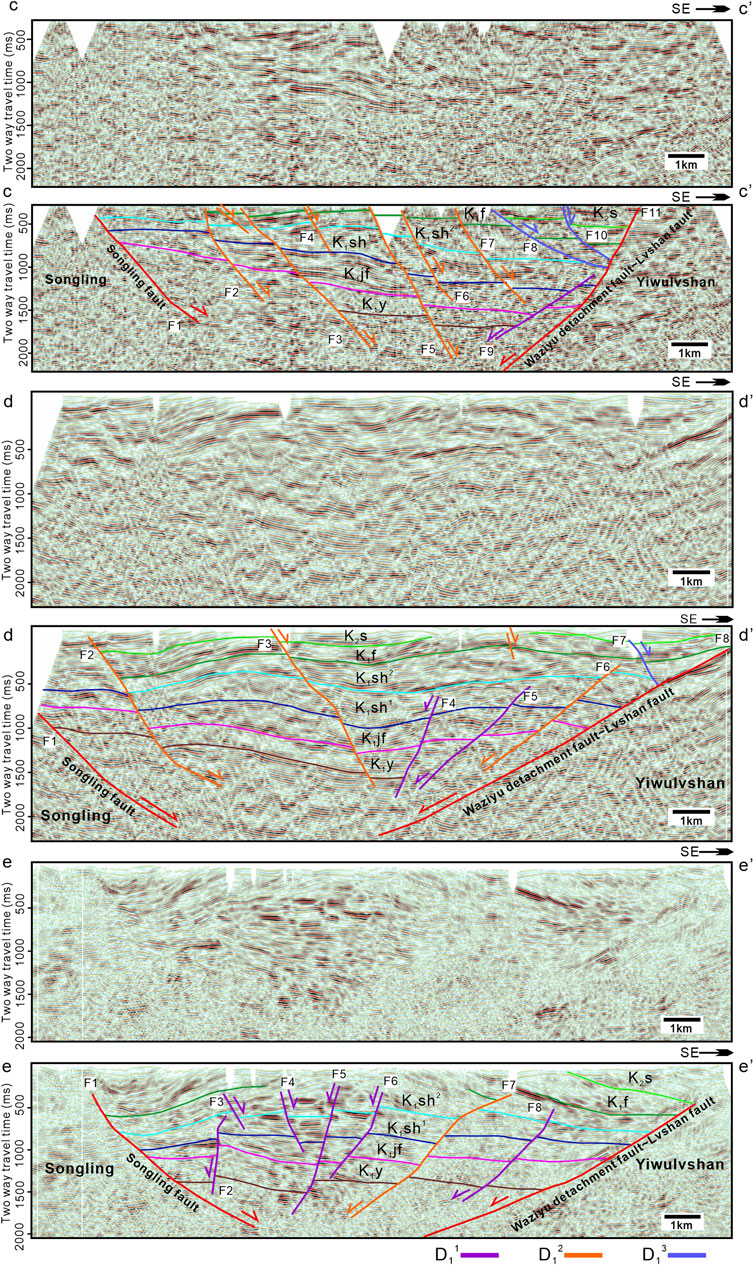- 1State Key Laboratory of Geological Processes and Mineral Resources, School of Earth Sciences and Resources, China University of Geosciences, Beijing, China
- 2Liaohe Oilfield Company, Panjin, China
- 3Geological Survey of Pakistan, Quetta, Pakistan
Supradetachment basins can record the stratigraphy and development of metamorphic core complexes (MCCs). The Fuxin supradetachment basin, which lies immediately to the west of the Yiwulvshan MCC in NE China, provides an excellent opportunity to establish the relationship between supradetachment basins and MCCs. In this study, we conducted field investigations, sedimentary facies analysis, and seismic profile interpretation to decipher the sedimentary processes and structural evolution of the basin and link them to the development of the Yiwulvshan MCC. The Fuxin Basin is filled predominantly by syn-rift volcanic sedimentary and post-rift clastic rocks, which developed in four stages, namely, proto-rift, fault subsidence, transition, and compression. The Fuxin Basin developed simultaneously with the two stages (earlier faulting-dominated and later exhumation stages) of development of the MCC. Erosion of the core of the Yiwulvshan MCC provided clastic material to the Fuxin Basin. Based on multi-stage reconstruction of the formation and evolution of the Fuxin Basin and Yiwulvshan MCC, we propose that rollback of the Paleo-Pacific Plate and retreat of the subduction trench provided the geodynamic setting for the crustal extension that formed the basin and MCC.
1 Introduction
Metamorphic core complexes (MCCs) comprise metamorphic rocks at the bottom and unmetamorphosed sequences at the top (e.g., Davis and Coney, 1979; Martinez et al., 2001; Whitney et al., 2013). Detachment fault zones are dominated by mylonite and separate the brittle top and ductile bottom of MCCs (e.g., Qiu et al., 2020a). The upper unit of an MCC develops brittle normal faults that merge into a master fault, with sedimentary basins being formed in association with this fault geometry. Supradetachment basins controlled by listric normal faults record the progressive development and evolution of detachment faults as well as the exhumation of MCCs (e.g., Friedmann and Burbank, 1995; Zeynep et al., 2011). Thus, the provenance of sedimentary rocks and the structural evolution of supradetachment basins are key to understanding the mechanism of formation of MCCs and reconstructing their evolution.
The Fuxin Basin, which is in the northern North China Craton (Qiu et al., 2020b), is a half-graben basin whose development and geometry have been controlled by the Songling and Waziyu normal faults. The basin is filled by Jurassic volcano-sedimentary and Cretaceous clastic rocks (e.g., Li et al., 1985; Cai et al., 2011; Su et al., 2020; Jia et al., 2021). Some studies have interpreted it as a supradetachment basin in the western part of the Yiwulvshan MCC (e.g., Jia et al., 2021). However, other studies have argued that the basin is a rift or back-arc basin of the Paleo-Pacific Plate (e.g., Li et al., 1988; Wei et al., 2010; Suo et al., 2020; Wu et al., 2019). The sedimentary–structural evolution of the basin thus remains uncertain. Nevertheless, the basin constitutes an excellent natural laboratory to reconstruct the evolution of the Yiwulvshan MCC.
In this study, we present results of field geological mapping, seismic profile imaging, and sedimentary facies analysis to reveal the development and evolution of the Fuxin Basin. We construct a structural and sedimentary model to link the development of the basin to the evolution of the Yiwulvshan MCC.
2 Geological Setting
2.1 Tectonic History
The Fuxin Basin is located on Liaodong Peninsula in the eastern North China Craton (Figure 1). During the Triassic, NE China was in a compressive tectonic environment as a result of Indosinian orogenesis (e.g., Li et al., 2017; Zhao et al., 2020; Dong et al., 2021). The collision between the North China and Siberian cratons during the Late Triassic formed the Central Asian Orogenic Belt (e.g., Windley et al., 2007; Xiao and Santosh, 2014). Also, during the Triassic, the North China Craton collided with the South China Block, producing the Qinling–Dabie and Sulu orogens. The Liaodong Peninsula lay between these collisional boundaries, forming an E- or NNE-striking fold–thrust belt (e.g., Yang et al., 2011). NW–SE-directed compression resulting from subduction of the Paleo-Pacific Plate during the Early–Middle Jurassic formed NE-oriented compressional depression basins. From the Jurassic to the Early Cretaceous, the regional structure changed markedly as a result of a transition from compression to extension in the overriding plate caused by rollback of the subducted Paleo-Pacific Plate (e.g., Xiao et al., 2003; Zhang et al., 2020; Ren et al., 2021). Large-scale lithospheric thinning took place, forming a series of NE- or NNE-trending extensional basins, and MCCs, including the Fuxin Basin (e.g., Wang et al., 1997; Li et al., 2007; Dong et al., 2008).
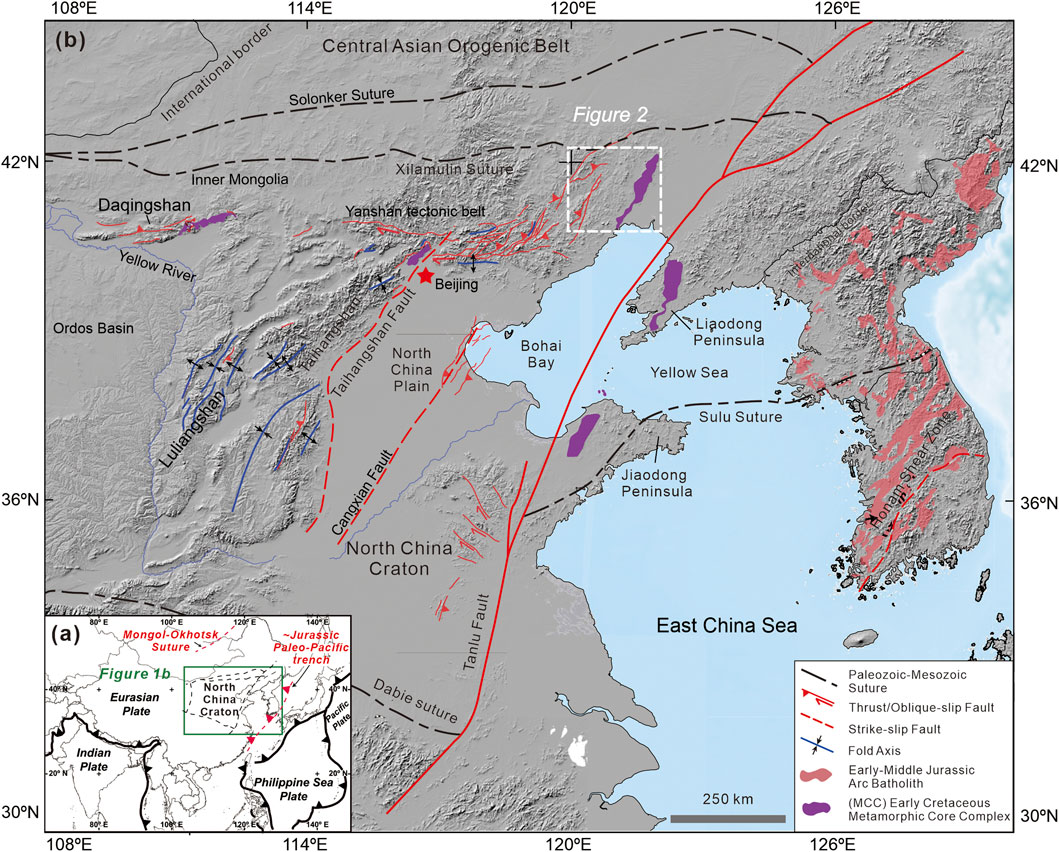
FIGURE 1. Tectonic sketch with digital elevation map of the North China Block and adjacent regions. (A) Inset map of tectonic sketch of northeastern Asia. (B) Simplified tectonic map and the MCC distribution of North China, showing the continents, suture zones, major faults, and location of the study area (after Clinkscales and Kapp, 2019).
2.2 Regional Geology
The western Liaoning region contains several Jurassic–Cretaceous NE- to N-trending basins, including the Beipiao, Jinyang, Chaoyang, Fuxin, Yixian, and Shaohuyingzi basins. The Early Cretaceous Fuxin and Yixian basins are located on the western Liaodong Peninsula and in the northeastern part of the Yanshan tectonic belt of the North China Craton (Figure 2). NE-striking normal, reverse, and strike-slip faults are widely distributed on the western Liaodong Peninsula. Larger normal faults, such as the Lvshan Fault, are generally developed along basin boundaries, and smaller normal faults are developed throughout the basins. The NW-dipping Nantianmen and Dongguanyingzi Faults are major reverse faults. At a regional map scale, there are two angular unconformities on the western Liaodong Peninsula: one between the Tuchengzi (J3–K1t) and Yixian (K1y) formations, and one between the Fuxin (K1f) and Sunjiawan (K2s) formations (Figure 3). The NNE- to NE-trending Fuxin and Yixian Basins are bordered by the NNE-trending Lvshan and Songling mountains to the east and west, respectively (Figure 3). The Fuxin Basin covers an area of 1500 km2 and is 11–22 km wide and 80 km long (e.g., Wu et al., 2007; Chen et al., 2019).
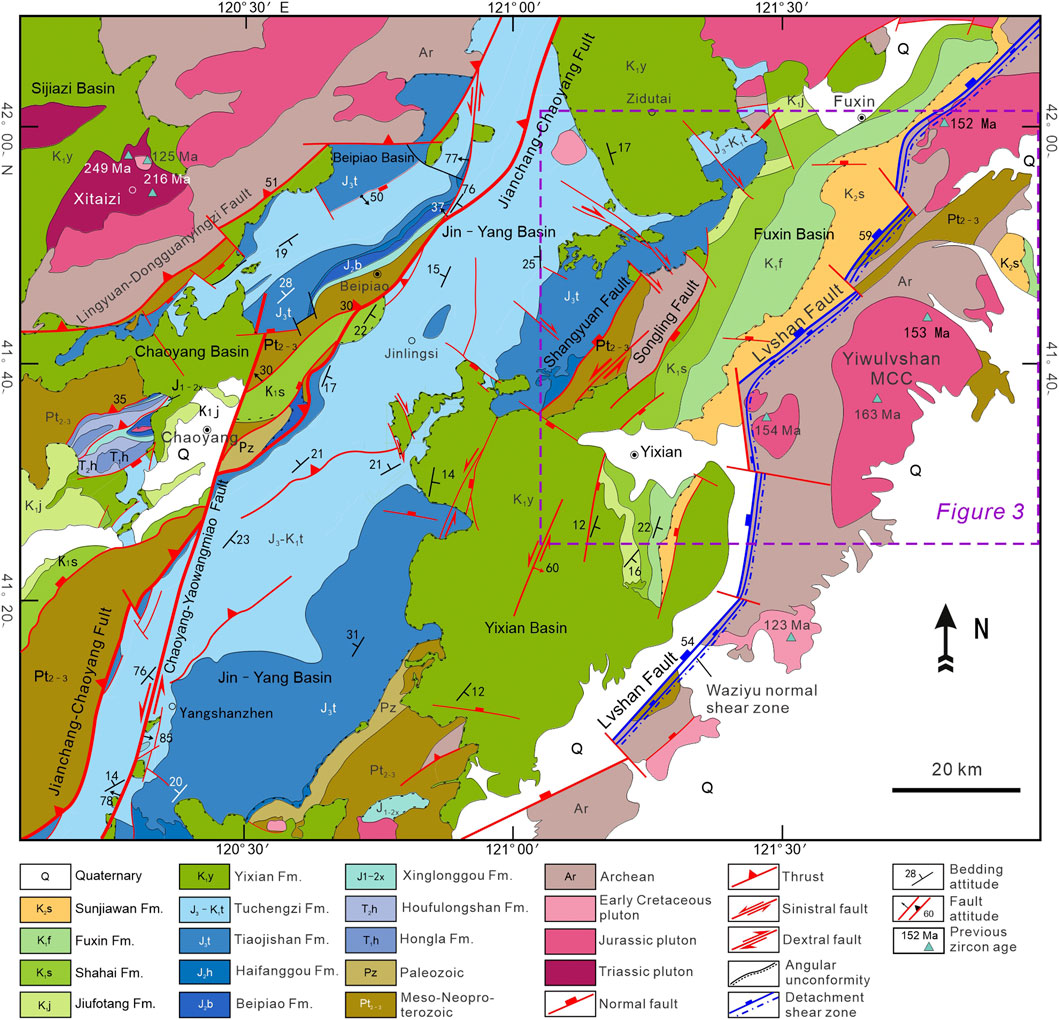
FIGURE 2. Geological map of the Yiwulvshan metamorphic core complex and Fuxin supradetachment basin in the eastern Asian margin (modified after Su et al., 2020).
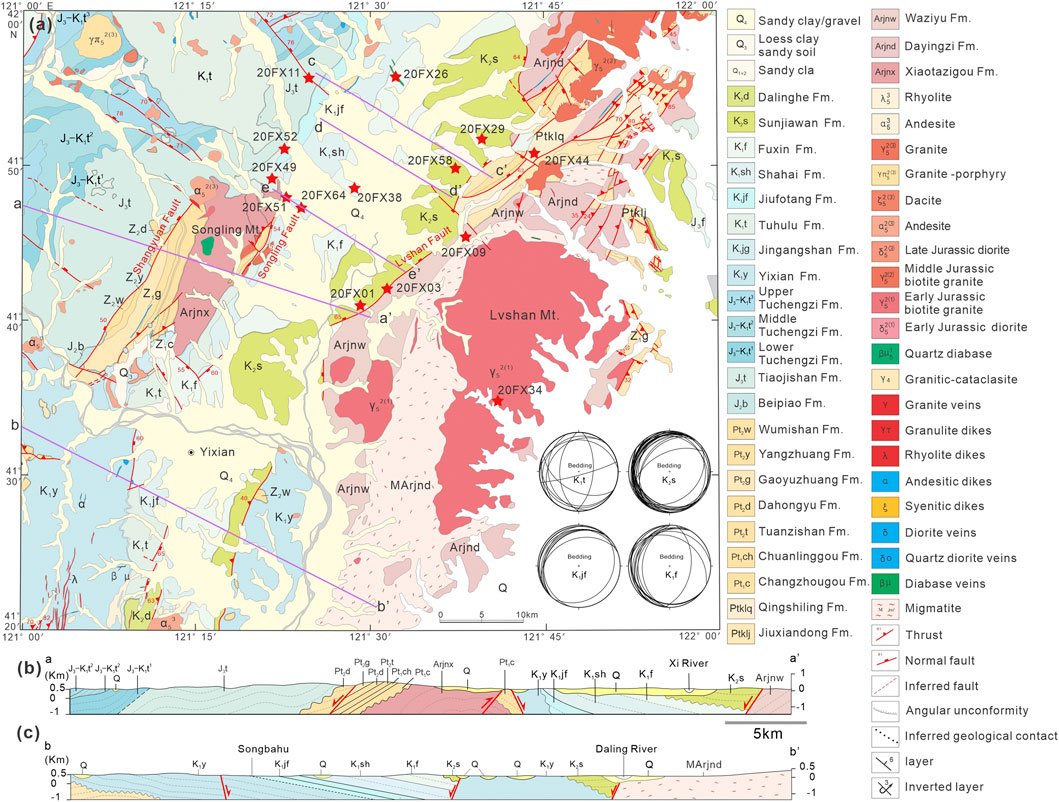
FIGURE 3. Geological map and transects of the Fuxin Basin on the Liaodong Peninsula (modified after the Regional Geological Map of Yixian, scale 1:20,000). (A) Geological map of the Fuxin Basin and adjacent area, showing the strata, faults, observation sites (red stars), and section lines. (B,C) Sections of NW–SE transects through the Fuxin Basin.
3 Data and Method
3.1 Data Summary
Based on the structural analysis on map view, we observed and collected field data of structures and strata from 72 field observation sites. We used Tensor software to analyze field data of structures. In addition, we selected representative seismic reflection profiles and borehole data from the dataset of Fuxin Basin that was conducted in the last half century. The dataset includes 4481 km of 2-D seismic data, 78 km2 of 2-D seismic data, and more than 3000 wells for coal exploration and approximately 10 wells for hydrocarbon exploration. These materials were used to study stratigraphy and structural patterns in the Fuxin Basin.
3.2 Sedimentary Facies
The lithology and logging curves and seismic data were conducted to reconstruct and interpret sedimentary facies and environments (Shi et al., 2012; Jia et al., 2021). The types of sedimentary facies in the Fuxin Basin have been identified directly from field outcrops and drill cores, including color, texture, bedding, structure, fossils, and mineral assemblage. Additionally, mud logging and well-log data without drill cores and 2-D seismic interpretation were used to infer sedimentary facies in areas without boreholes and fault patterns (Jia et al., 2014). All data in this study were collected by the Liaohe Oilfield Company, Petrochina, China.
4 Geology of the Fuxin Basin
4.1 Stratigraphy and Sedimentology
Mesozoic strata distributed in the Fuxin Basin are mainly Cretaceous in age (K2s, Sunjiawan Formation; K1f, Fuxin Formation; K1sh, Shahai Formation; K1jf, Jiufotang Formation; and K1y, Yixian Formation). The Tiaojishan (J3t) and Tuchengzi (J3–K1t) formations are poorly exposed in the western Fuxin Basin. The Lower Cretaceous strata unconformably overlie Archean metamorphic rocks (Figure 4).
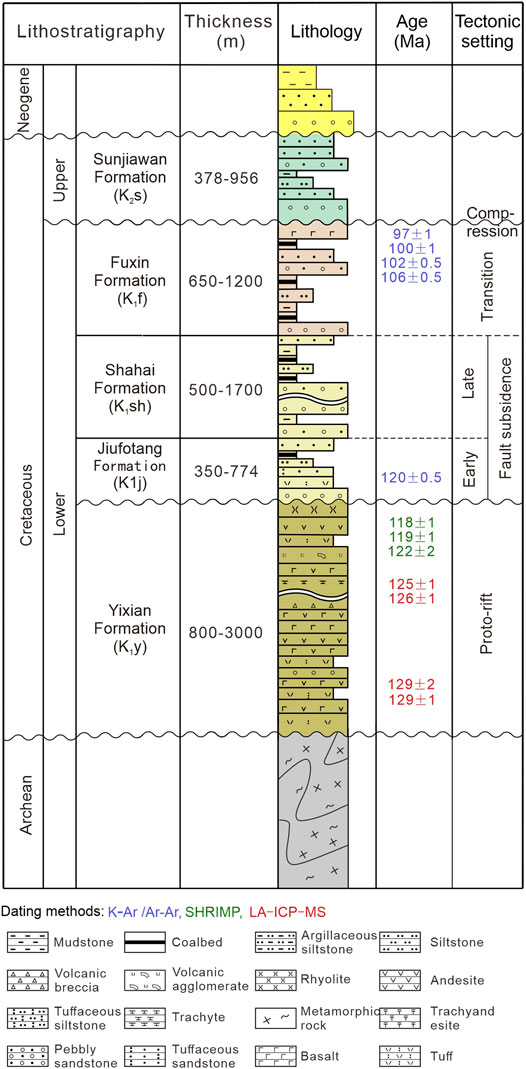
FIGURE 4. Columnar section of the Fuxin Basin (modified after Su et al., 2020; Jia et al., 2021).
Controlled by the Lvshan Fault, the Sunjiawan Formation is distributed in the eastern and northeastern margins of the Fuxin Basin (Figure 3). The lithology comprises mainly conglomerate and glutenite, intercalated with sandstone, and shale. The conglomerate is poorly cemented, with clasts showing a wide range of compositions, poor sorting, and subangular–subrounded shapes. The maximum size of the clasts is greater than 2 m.
The Fuxin Formation is unconformably overlain by the Sunjiawan Formation and is widely exposed in the eastern and northern margins of the Fuxin Basin. This formation is composed of sandstone, glutenite, shale, and coal seams. Cross-bedding structures measuring 5–6 m long and 0.5 m high are observed. The lithological assemblage and sedimentary structures indicate that the Fuxin Formation was deposited in a sedimentary environment consisting of floodplains and swamps.
The Shahai Formation is conformably overlain by the Fuxin Formation and divided into four members. From bottom to top, the first and second members are composed mainly of siliceous cemented conglomerate, and the third member consists predominantly of greyish-green mudstone and dark-grey carbonaceous mudstone, intercalated with gray feldspar debris, medium- to coarse-grained sandstone, and thin layers of black coal. The fourth member comprises mainly dark-gray and gray mudstone of deep- and moderately deep-lacustrine facies. In addition, subaqueous fan deposits with intervening sub-deep-water gravity flow sandy conglomerates are found in the eastern part of the basin, and fan-delta deposits are developed over the entire Fuxin Basin.
The Jiufotang Formation is conformably overlain by the Shahai Formation. The lower Jiufotang Formation is dominated by tuffaceous conglomerate and sandstone, gray–green tuffaceous mudstone, and gray–green calcareous shale that were deposited in an alluvial-fan–shallow-lacustrine environment. The middle part of the formation is dominated by a set of fine-grained sedimentary rocks, with extensive grayish-green, dark-gray, and black mudstone, and represents further development of the lacustrine depositional environment. The upper part of the formation comprises a set of variegated conglomerates containing volcanic gravel intercalated within grayish green to light-red mudstone that was deposited in a moderately deep lake. The period of sedimentation of the Jiufotang Formation represents subsidence during the initial expansion of the Fuxin Basin, involving transformation from alluvial-fan to fan-delta and moderately deep-lacustrine environments.
The Yixian Formation is unconformably overlain by the Jiufotang Formation. The Yixian Formation is divided into the Yixian, Jingangshan, and Tuhulu members from bottom to top. The Yixian Member is dominated by a volcanic rock assemblage evolving from mafic to felsic, intercalated with multi-cycle intermittent volcanic sediments. Grayish-green to purplish-red andesite and porphyritic trachyandesite are widely developed and show extensive stomatal almonds structure. The Tuhulu Member comprises agglomerate, tuffaceous sandstone, and mudstone and shows cross-, parallel-, and horizontal-bedding.
4.2 Structures
4.2.1 Mesoscopic Structures
There are few outcrops of the Cretaceous stratigraphy in the Fuxin Basin, meaning that a limited number of structural features were observed in the field (Figure 5). During our field investigation, we observed two large-scale folds in the Fuxin Basin, exposed in an abandoned coal mine. The folded strata are ∼1 m thick and comprise sandstone and a coal seam. The twofold axes trend 82° with a dip angle of 64° and 165° with a dip angle of 77°, respectively. Some smaller structures were also observed (Figure 6). Stress tensor data for joints recorded in dolomite and tuff to the east (Figure 6G) and west (Figure 6H) of the basin analyzed using Tensor software show a NE–SW-directed compressive stress field, which reflects a compressional setting in the study area before the formation of the Fuxin Basin.
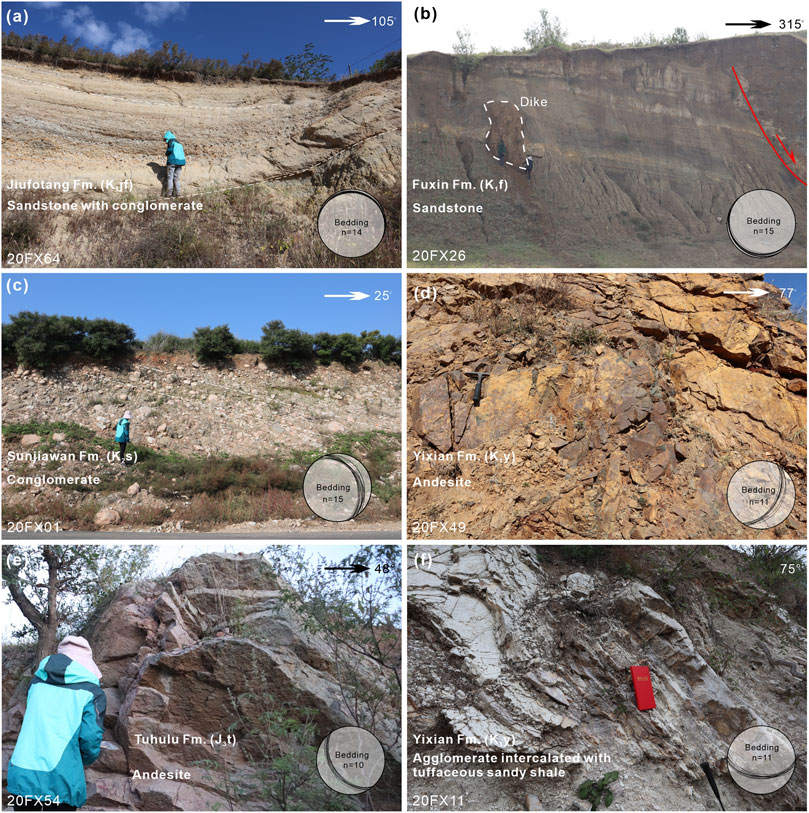
FIGURE 5. Field photographs of the Fuxin Basin, showing the sedimentology and unconformities. (A) Conglomerates in the Shahai Formation. (B) Mafic dyke intruding sandstone of the Fuxin Formation that is cut by a normal fault. (C) Sandstone with conglomerate in the Jiufotang Formation. (D,E) Andesite in the Yixian and Tiaojishan formations. (F) Agglomerate interlayered with tuffaceous sandy shale in the Yixian Formation.
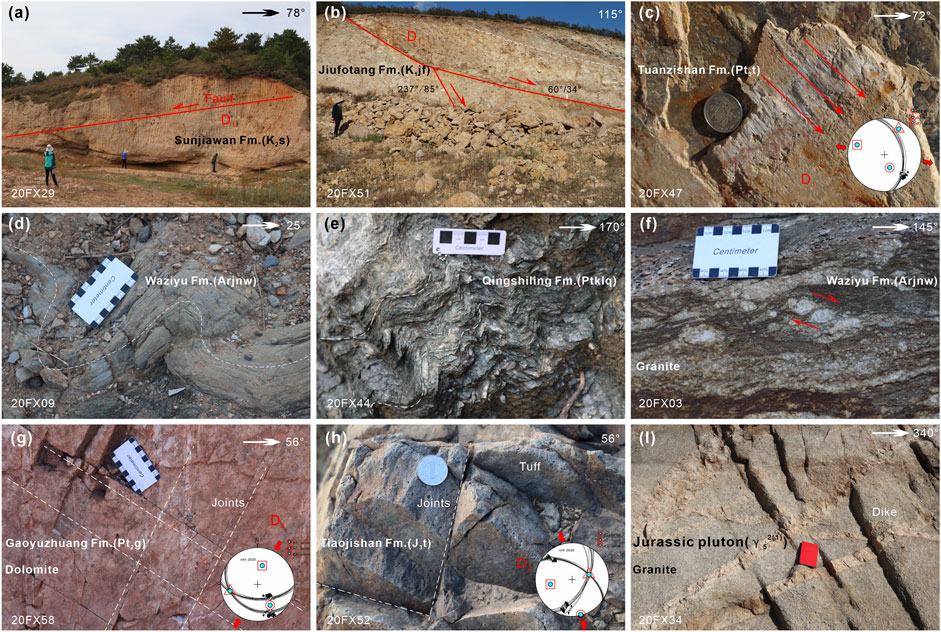
FIGURE 6. Field photographs of the Fuxin Basin, showing structural patterns, mesoscopic structures, and kinematics. (A) Normal fault dipping to the northeast in the Shahai Formation. (B) Normal fault cutting the Jiufotang Formation. (C) Slickenside on fault plane cutting the Neoproterozoic basement.; (D) Folds in the Archean basement. (E) Folds in the Proterozoic basement. (F) Porphyry clasts in granitic mylonite showing dextral shearing. (G) Joints cutting Neoproterozoic dolomite. (H) Joints developed within Late Jurassic Tiaojishan tuffaceous rocks. (I) Felsic dykes truncating granite in the core of the Yiwulvshan MCC to the east of the Fuxin Basin.
We observed three normal faults in the Fuxin Basin, which cut through the Sunjiawan, Fuxin, and Jiufotang Formations, respectively (Figures 6A,B). The fault that cuts through the Shahai Formation extends along the boundary between this formation and Quaternary strata. The 30-m-long fault plane strikes 091° with a dip angle of 40°. The fault cutting through the Fuxin Formation is developed at the junction of sandstone and a mafic dyke (Figure 5B). The 10-m-long fault plane strikes 155° with a dip angle of 48°. Three intrusive dykes can be seen at the outcrop of this fault. Microscopic observations show that these three rock bodies are composed of olivine, feldspar, and pyroxene, consistent with a basaltic composition. The 10-m-long fault in the Jiufotang Formation strikes 060° with a dip angle of 34°. The fault plane cuts through another smaller normal fault below that strikes 237° with a dip angle of 85°.
4.2.2 Seismic Reflection Profiles
We obtained high-resolution seismic reflection profiles from the Fuxin Basin over an area of ∼2000 km2. Multichannel seismic data were collected and processed (filtered and stacked) using Landmark software. The results presented here are based on interpretations of ultrahigh-resolution chirp profiles and time slices analyzed using this software. Data from several deep boreholes (Figure 3) were also used for well-ties with the seismic data.
Seismic profile c–c′ shows 11 faults (F1–F11; Figures 7C, C′). Faults F1 (Songling Fault) and F11 (Lvshan Fault) are located on the eastern and western sides of the basin, respectively. These are two oppositely inclined listric faults with large offset, cutting the strata of the Yixian to Fuxin formations in the basin and controlling the sedimentary evolution of the Fuxin Basin as boundary faults. The F11 (Lvshan Fault) is a high-angle normal fault that gradually shallows in deeper strata and transitions into the Waziyu detachment fault. F3 and F5 are two east-dipping listric secondary faults that also cut all of the strata from the Yixian to Fuxin formations. F2, F6, and F7 are three ∼2.5-km-long east-dipping listric normal faults that cut the Jiufotang to Fuxin formations. F8 and F10 have shallow dip angles and control the deposition of the Sunjiawan Formation in the eastern Fuxin Basin, cutting the Shahai to Sunjiawan formations.
Seismic profile d–d′ shows eight faults (F1–F8; Figures 7D, D′). The characteristics of F1 (Songling Fault) and F8 (Lvshan Fault) are the same as those in profile c–c′ described previously. F2 and F3 are two east-dipping listric secondary faults and cut the Yixian to Fuxin formations. F4, F5, and F6 are three ∼2.5-km-long faults that cut the Yixian to lower Shahai formations. F4–F6 form a series of west-dipping listric faults whose respective dips steepen progressively toward the center of the basin, thereby converging downward and intersecting with the main eastern boundary fault to form a fault terrace. F7 is a 1-km-long normal fault developed in shallow strata and dips eastward, opposite in a sense to faults developed in the deeper strata.
Seismic profile c–c′ reveals nine faults (F1–F9; Figures 7E, E′). The characteristics of F1 (Songling Fault) and F8 (Lvshan Fault) are the same as those in profiles c–c′ and d–d′. F2 is a high-angle west-dipping normal fault in the western part of the profile and cuts the Yixian Formation to the lower Shahai Formation. F3 and F4 are two small-scale listric faults. F3 cuts only the upper Shahai Formation, but F4 cuts the entire formation. F3 to F6 together form a ∼3.5-km-wide graben. F7 cuts the Yixian to Fuxin formations, and F8 cuts the Yixian Formation to the upper Shahai Formation. Both faults are listric and dip to the west.
The faults in the Fuxin Basin as revealed by the seismic profiles are mainly listric normal faults, with small grabens being developed locally. Integrating the three profiles, the basin can be divided into three structural zones: the western step-fault zone, central graben zone, and eastern step-fault zone.
4.2.3 Sequence of Deformation
On the basis of deformation style and the cross-cutting relationships between strata and faults observed in seismic profiles and outcrops, and disregarding the pre-D1 shortening events marked by faults and folds of the basement rocks, we define three stages of deformation during D1 extension: 1) D11, extensional deformation represented by normal faults controlling the deposition of the Yixian Formation to the first member of the Shahai Formation (K1y–K1sh1); 2) D12, extensional deformation represented by normal faults controlling the deposition of the Yixian to Fuxin formations (K1y–K1f); and 3) D13, extensional deformation represented by low-angle normal faults and coeval secondary faults controlling the deposition of the second member of the Shahai Formation to the Sunjiawan Formation (K2s–K1sh2).
Integrating the regional geology with the results of the present study allows chronological constraints to be placed on the three stages of deformation. The timing of D11 is contained by the deposition of K1sh2 and K1sh1, which lasted until approximately 113 Ma (He et al., 2004; Zhu et al., 2004); the end of D12 is constrained by the deposition of K2s and K1f, at approximately 97 Ma (Zheng et al., 2004); and D13 took place after the deposition of K2s, after the cessation of MCC activity, through to approximately 57 Ma (Lin et al., 2013).
5 Discussion
5.1 Model of the Evolution of the Fuxin Basin
5.1.1 Pre-Extensional Deformation
Lower Cretaceous strata of the Fuxin Basin lie directly on pre-Sinian basement, which underwent multi-stage structural deformation before the formation of the basin. During the Early and Middle Jurassic, owing to westward subduction of the Paleo-Pacific Plate, the Liaodong Peninsula underwent NW–SE-directed compression, forming NE-oriented fold–thrust structures and compression-related depression basins (e.g., Yang et al., 2011; Qiu et al., 2018).
5.1.2 Evolution of the Extensional Environment
During the formation of the Yixian Formation, strong regional extension led to the development of the Waziyu detachment fault and rapid uplift and exhumation of the Yiwulvshan MCC (Liang et al., 2020; Su et al., 2020). Large-scale volcanic eruptions occurred, forming an association of mafic–intermediate–felsic volcanic rocks belonging to the calc-alkaline series. The source magma of these rocks was derived from the lithosphere with a component of metasomatized subducted oceanic crust (Wu et al., 2005; Pei et al., 2011).
With the weakening of volcanism during the development of the Yixian Formation and the continuing uplift of the Yiwulv Mountains to the east, the Fuxin Basin entered the sedimentary period corresponding to deposition of the Jiufotang Formation. A fan-delta–shallow-lake sedimentary system developed on both the western and eastern sides of the basin. With the expansion of the lacustrine-based basin, subsidence and deepening of the lakes occurred, into which sediments were deposited, ranging from moderately deep- to shallow-lake facies together with locally developed fan-delta deposits and fan slumps (Figure 8A).

FIGURE 8. Sedimentary facies of the formations of the Fuxin Basin. (A) Jiufotang Formation. (B) First member of the Shahai Formation. (C) Fourth member of the Shahai Formation. (D) The Fuxin Formation.
During deposition of the first member of the Shahai Formation, regional extension became more pronounced, and the rate of uplift of mountain ranges bordering the Fuxin Basin increased. In addition, the sedimentary area of the basin underwent marked expansion, with lake environments correspondingly shallowing and reducing in area and being transformed to fan-delta and plain sedimentary environments (Figure 8B).
During the depositional period of the fourth member of the Shahai Formation, the Fuxin Basin continued to extend and formed an extensive area of sediments of moderately deep-lacustrine facies. A fan-delta–lake sedimentary system developed in the eastern part of the basin, and several small-scale slump-fan deposits formed at the ends of fan deltas. In the western part of the basin, owing to the reduced influence of the Songling Fault, a small-scale fan-delta–shallow-lake sedimentary system developed but without slump-fan deposition, and some strata were locally uplifted and eroded (Figure 8C).
During the depositional period of the Fuxin Formation, the activity of the Songling Fault in the west of the basin and the Waziyu detachment fault in the east weakened, and expansion of the basin ceased. Strata in the west of the basin continued to be eroded, large-scale alluvial-fan sediments and local swamp-facies deposits developed in the center of the basin, and lacustrine sedimentation stopped. Swamp-facies deposits developed in areas of subsidence, forming a high-quality coal seam in the Fuxin Formation, as exposed at Haizhou open-pit coal mine (Figure 8D).
Deposition of the Sunjiawan Formation was controlled by the uplift of the Yiwulv Mountains to the east of the Fuxin Basin. The Sunjiawan Formation is developed only near the eastern boundary fault of the basin, where narrow, large-scale alluvial-fan deposits are found, alongside variegated molasse deposits with a thickness of several hundred meters. The central–western part of the basin was severely eroded because of local uplift.
In summary, the sedimentary evolution of the Fuxin Basin included two phases of lacustrine expansion and two phases of lacustrine contraction. There was continuous expansion of lake bodies from the deposition of the lower Jiufotang Formation until gradual shrinkage during the deposition of the lower Shahai Formation. The climax of the lacustrine environment in terms of lake extent and depth occurred during the deposition of the upper Shahai Formation, following which the lakes shrank during deposition of the upper Shahai to Sunjiawan Formations (Figure 9).

FIGURE 9. Sedimentary section compiled from borehole data from the Fuxin Basin, showing the vertical variation in the sedimentary facies.
5.2 Implications for the Evolution of the Yiwulvshan MCC
The Mesozoic tectonic evolution of the Yiwulvshan NCC was characterized by tectonic switching from early Mesozoic shortening to late Mesozoic extension (e.g., Yan et al., 2021). The extensional tectonic regime identified from structures in the present study is reflected in the development of the Yiwulvshan MCC, the Fuxin superdetachment basin, and normal faulting. Lin et al. (2013) proposed that the deformation of the Yiwulvshan MCC can be divided into two stages, namely, D1 and D2. D1 deformation is defined by compressional structures that developed in the Yiwulv Mountains from the Late Jurassic to the Early Cretaceous (ca. 141 Ma). D2 deformation represents an Early Cretaceous extension event at approximately 126 Ma (e.g., Li et al., 2012; Lin et al., 2013; Li et al., 2016). Furthermore, Liang et al. (2020) proposed that the D2 extensional event involved the main period of cooling and exhumation of the Yiwulvshan MCC along the Waziyu ductile shear zone on the western boundary of the Fuxin Basin between 130 and 100 Ma. The Late Jurassic to Early Cretaceous (135–130 Ma) extension was caused by movement on a low-angle detachment fault rooted in the middle crust (e.g., Liang et al., 2020). The Early Cretaceous (ca. 125 Ma) syn-tectonic magmatism resulted in isostatic rebound and in the abandonment of the initial breakaway and MCC dome formation. The timing of formation of the MCC is coeval with the timing of the Early Cretaceous magmatism. Previous studies have shown that the oldest age of the volcanic rocks of the Yixian Formation deposited during the early stage of development of the Fuxin Basin is 129 Ma (Xu et al., 2012; Zhang et al., 2016). Early Cretaceous (115–97 Ma) detachment of the upper plate and isostatic uplift of the lower plate, and a new breakaway developed in the transport direction and subsequently the activity of the MCC ceased. The late stage of deposition of the Fuxin Formation in the Fuxin Basin involved contraction of the lacustrine sedimentary environment and corresponded to the cessation of MCC activity. The oldest age of the Fuxin Formation is 100–97 Ma (e.g., Zhang et al., 2003; Zheng et al., 2004; Sun et al., 2010; Zhang et al., 2012), which is consistent with the timing of cessation of MCC evolution. According to the provenance arrows in sedimentary facies diagrams (Figure 8), erosion of the core of the Yiwulvshan MCC provided clastic materials for the filling of the Fuxin Basin. The interpreted seismic profiles (Figure 7) show that the deposition of sediments into the Fuxin Basin was controlled by the Waziyu detachment fault. In summary, we propose that the Fuxin Basin is a supradetachment basin located to the west of the Yiwulvshan MCC.
5.3 Tectonic Implications
The close spatial and temporal relationship between volcanic and sedimentary strata in the Fuxin Basin and the Yiwulvshan MCC to the east of the basin shows that the eastern NCC was in an extensional regime during the Early Cretaceous. Su et al. (2020) proposed four stages of deformation during the Cretaceous on the western Liaodong Peninsula, of which the first stage was characterized by compression during the early Cretaceous (137–136 Ma). The regional angular unconformity in the Fuxin Basin and in the nearby Yixian and Jinyang Basins can be used to constrain the transition time from compression to extension. Zircon U–Pb ages for the Tuchengzi Formation (J3–K1t) below the angular unconformity and the Zhangjiakou Formation (K1z) above the angular unconformity constrain the transition to 137–136 Ma (Su et al., 2020).
Integration of fieldwork results with seismic-profile data and sedimentary-facies information suggests that volcanic rocks of the Yixian Formation were deposited in the Fuxin Basin at 129–118 Ma (Xu et al., 2012; Zhang et al., 2016). The duration of magmatic activity in the region is around 29 Myr. From southwest to the northeast across the Fuxin and Yixian basins, ages of volcanic rocks of the Yixian Formation show a younging trend. Early Cretaceous igneous rocks in western Liaoning were derived mainly from the partial melting of crustal materials or lithospheric mantle (Wu et al., 2005; Pei et al., 2011). Therefore, we propose that the Fuxin supradetachment basin and the related Yiwulvshan MCC constitute an extensional basin that formed as a result of westward subduction and eastward trench retreat of the Paleo-Pacific Plate (e.g., Dmitrienko et al., 2016; Li et al., 2018).
6 Conclusion
Our multidisciplinary study of the stratigraphy and structure of the Fuxin Basin in NE China allows the following conclusions to be made:
1) The Fuxin Basin is a supradetachment basin located to the west of the Yiwulvshan MCC. The basin contains sedimentary rocks of the Yixian Formation (proto-rift), the Jiufotang and Shahai Formations (fault subsidence), the Fuxin Formation (transition), and the Sunjiawan Formation (post-rift). These sedimentary rocks were deposited during 120–97 Ma after a compressive event.
2) Mesoscopic-scale structures and seismic profiles reveal two deformation events, i.e., D1 and D2. D1 represents the expansion of the Fuxin Basin under the control of normal faults and can be divided into three stages: D11, D12, and D13. The three stages of D1 deformation are respectively defined by a group of large-scale normal faults that developed during the deposition of all strata in the basin, high-angle normal faults that developed during deposition of the fourth member of the Shahai Formation, and inverted low-angle normal faults that developed during deposition of the Sunjiawan Formation. D2 deformation is defined by the folds and the angular unconformity between the Fuxin and Sunjiawan Formations and by the shortening that occurred between deposition of these two formations. The deformations are consistent with the sedimentary facies of the basin, including two phases of expansion and two phases of contraction of lacustrine sedimentary environments, indicating that the basin developed in four phases: proto-rift, fault subsidence, transition, and compression.
3) Integrating our new stratigraphic and structural results with the regional geology and nearby coeval rift basins, the Fuxin Basin is interpreted as a supradetachment basin. The tectonic activity of the Yiwulvshan MCC and deposition of the Fuxin Formation ceased simultaneously at 100–97 Ma. Rollback of the Paleo-Pacific slab and slab retreat provided the geodynamic setting that caused tectonic extension and the development of the Fuxin Basin (Figure 10).
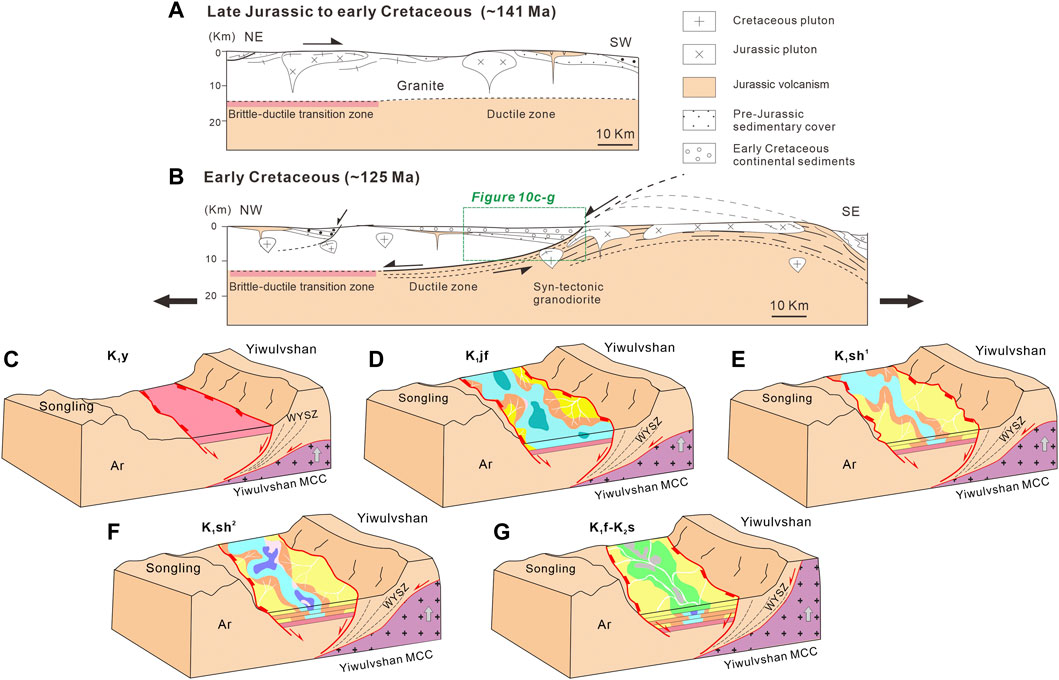
FIGURE 10. Model of the evolution of the Fuxin Basin, NE China. (A,B) Tectonic evolution of the Yiwulvshan MCC from compression to extension (modified after Lin et al., 2013). (C) Early Cretaceous (ca. 125 Ma) syn-tectonic magmatism generated isostatic rebound that resulted in abandonment of the initial breakaway and dome formation. (D) The Fuxin Basin expanded during deposition of the Jiufotang Formation, with a lacustrine sedimentary environment prevailing in the basin. (E) Extension intensified, and lakes reduced in area and depth, leading to only limited areas of lacustrine conditions in the basin. (F) The Fuxin Basin expanded and formed an extensive area of moderately deep-lacustrine facies. (G) Activity of the MCC ceased, the Fuxin Basin stopped expanding, and the lacustrine sedimentary environment was terminated.
Data Availability Statement
The original contributions presented in the study are included in the article/Supplementary Material. Further inquiries can be directed to the corresponding authors.
Author Contributions
SS: investigation, data analysis, writing—original draft, writing—review and editing. LQ: conceptualization, investigation, writing—original draft, writing—review and editing. DY: conceptualization, writing—original draft, writing—review and editing. ZZ: methodology, writing—review and editing. JZ: investigation, methodology. XW: methodology, data analysis, writing—review and editing. BW: methodology, data analysis. HS: methodology, data analysis. SA: writing—review and editing. RC: methodology, writing—review and editing. YF: investigation, writing—review and editing. YW: investigation, writing—review and editing.
Funding
This study was financially supported by funding from the Ministry of Science and Technology of the People’s Republic of China (2016YFC0600102-03) and the National Natural Science Foundation of China (Grants 42030306 and 41702207).
Conflict of Interest
Author JZ and HS is employed by Liaohe Oilfield Company.
The remaining authors declare that the research was conducted in the absence of any commercial or financial relationships that could be construed as a potential conflict of interest.
Publisher’s Note
All claims expressed in this article are solely those of the authors and do not necessarily represent those of their affiliated organizations, or those of the publisher, the editors, and the reviewers. Any product that may be evaluated in this article, or claim that may be made by its manufacturer, is not guaranteed or endorsed by the publisher.
Acknowledgments
We thank Tao Yang for running Tensor software and Qihui Zhang and Weijie Zhang for logistics support. We appreciate constructive comments from Guest Editor Prof. Xiubin Lin, Chengming Li, and two reviewers.
References
Cai, H. A., Li, B. F., Shao, L. Y., Xu, D. B., Shao, K., and Zhou, Y. Y. (2011). Sedimentary Environments and Coal Accumulation Patterns of the Lower Cretaceous Shahai Formation in Fuxin Basin, Liaoning Province. J. Palaeogeogr. 13, 481–491. doi:10.1007/s12583-011-0163-z
Chen, D., Zhang, J., Lan, B., Wang, X., and Wang, Z. (2019). Influence of Sedimentary Environment on the Shale Gas Reservoir of Sahai Formation in Fuxin Basin, Northeast China. Energy Sourc. A: Recovery, Utilization, Environ. Effects 41, 1949–1959. doi:10.1080/15567036.2018.1548506
Clinkscales, C., and Kapp, P. (2019). Structural Style and Kinematics of the Taihang-Luliangshan Fold belt, North China: Implications for the Yanshanian Orogeny. Lithosphere 11 (6), 767–783. doi:10.1130/l1096.1
Davis, G. H., and Coney, P. J. (1979). Geologic Development of the Cordilleran Metamorphic Core Complexes. Geol 7 (3), 120–124. doi:10.1130/0091-7613(1979)7<120:gdotcm>2.0.co;2
Dmitrienko, L. V., Li, S. Z., Cao, X. Z., Suo, Y. H., Wang, Y. M., Dai, L. M., et al. (2016). Large-scale Morphotectonics of the Ocean-Continent Transition Zone between the Western Pacific Ocean and the East Asian Continent: a Link of Deep Process to the Earth' S Surface System. Geol. J. 51, 263–285. doi:10.1002/gj.2845
Dong, S. W., Zhang, Y. Q., Chen, X. H., Long, C. X., Wang, T., Yang, Z. Y., et al. (2008). The Formation and Deformational Characteristics of East Asia Multi-Direction Convergent Tectonic System in Late Jurassic. Acta Geoscientica Sinica 29, 306–317.
Dong, Y., Sun, S., Santosh, M., Zhao, J., Sun, J., He, D., et al. (2021). Central China Orogenic Belt and Amalgamation of East Asian Continents. Gondwana Res. 100, 131–194. doi:10.1016/j.gr.2021.03.006
Friedmann, S. J., and Burbank, D. W. (1995). Rift Basins and Supradetachment Basins: Intracontinental Extensional End-Members. Basin Res. 7 (2), 109–127. doi:10.1111/j.1365-2117.1995.tb00099.x
He, H. Y., Wang, X. L., Zhou, Z. H., Wang, F., Boven, A., Shi, G. H., et al. (2004). Timing of the Jiufotang Formation (Jehol Group) in Liaoning, Northeastern china, and its Implications. Geophys. Res. Lett. 31 (12), 261–268. doi:10.1029/2004gl019790
Jia, J., Liu, Z., Miao, C., Fang, S., Zhou, R., Meng, Q. A., et al. (2014). Depositional Model and Evolution for a Deep-Water Sublacustrine Fan System from the Syn-Rift Lower Cretaceous Nantun Formation of the Tanan Depression (Tamtsag Basin, Mongolia). Mar. Pet. Geology. 57, 264–282. doi:10.1016/j.marpetgeo.2014.05.022
Jia, J., Wu, Y., Miao, C., Fu, C., Xie, W., Qin, J., et al. (2021). Tectonic Controls on the Sedimentation and Thermal History of Supra‐detachment Basins: A Case Study of the Early Cretaceous Fuxin Basin, NE China. Tectonics 40 (5). doi:10.1029/2020TC006535
Li, G., Liu, Z., Liu, J., Li, Y., Xu, Z., and Dong, X. (2012). Formation and Timing of the Extensional Ductile Shear Zones in Yiwulü Mountain Area, Western Liaoning Province, North China. Sci. China Earth Sci. 55, 733–746. doi:10.1007/s11430-012-4397-0
Li, J. B., Wang, T., Guo, L., Ouyang, Z. X., Zeng, T., Ding, Y. J., et al. (2016). Formation of Late Jurassic-Early Cretaceous Metamorphic Core Complexes in Northeast China: Insight from a Structural Study of the Yiwulüshan Ductile Detachment Zone. Int. Geology. Rev. 58, 1443–1460. doi:10.1080/00206814.2016.1155505
Li, S., Jahn, B.-m., Zhao, S., Dai, L., Li, X., Suo, Y., et al. (2017). Triassic Southeastward Subduction of North China Block to South China Block: Insights from New Geological, Geophysical and Geochemical Data. Earth-Science Rev. 166, 270–285. doi:10.1016/j.earscirev.2017.01.009
Li, S. T., Xia, W. C., Yang, S. G., Huang, J. F., and Wu, C. L. (1985). Turbidity Current Deposits of the Shahai Formation in Fuxin Basin and Their Spatial Relations with Other Facies. Acta Geologica Sinica 01, 61–73. doi:10.1111/j.1525-1314.1985.tb00331.x
Li, S. T., Yang, S. G., Wu, C. L., Huang, J. F., Cheng, S. T., Xia, W. C., et al. (1988). Late Mesozoic Rifting in Northeast China and Northeast Asia Fault basin System. Sci. China (Ser. B) 31, 246–256.
Li, S. Z., Kusky, T. M., Zhao, G., Wu, F., Liu, J.-Z., Sun, M., et al. (2007). Mesozoic Tectonics in the Eastern Block of the North China Craton: Implications for Subduction of the Pacific Plate beneath the Eurasian Plate. Geol. Soc. Lond. Spec. Publications 280, 171–188. doi:10.1144/sp280.8
Li, S. Z., Suo, Y., Li, X., Wang, Y., Cao, X., Wang, P., et al. (2018). Mesozoic Plate Subduction in West pacific and Tectono-Magmatic Response in the East Asian Ocean-Continent Connection Zone. Chin. Sci. Bull. 63 (16), 1550–1593 doi:10.1360/n972017-01113
Liang, C., Neubauer, F., Liu, Y., Heberer, B., Genser, J., Dunkl, I., et al. (2020). Diachronous Onset and Polyphase Cooling of the Taili-Yiwulüshan Metamorphic Core Complex Corridor, NE China, and its Relationships to the Formation of Adjacent Extensional Basins. Gondwana Res. doi:10.1016/j.gr.2020.09.004
Lin, W., Charles, N., Chen, Y., Chen, K., Faure, M., Wu, L., et al. (2013). Late Mesozoic Compressional to Extensional Tectonics in the Yiwulüshan Massif, NE China and Their Bearing on the Yinshan-Yanshan Orogenic belt. Gondwana Res. 23 (1), 78–94. doi:10.1016/j.gr.2012.02.012
Martinez, F., Goodliffe, A. M., and Taylor, B. (2001). Metamorphic Core Complex Formation by Density Inversion and Lower-Crust Extrusion. Nature 411 (6840), 930–934. doi:10.1038/35082042
Oner, Z., and Dilek, Y. (2011). Supradetachment basin Evolution during continental Extension: The Aegean Province of Western Anatolia, Turkey. Geol. Soc. America Bull. 123, 2115–2141. doi:10.1130/b30468.1
Pei, F.-P., Xu, W.-L., Yang, D.-B., Yu, Y., Wang, W., and Zhao, Q.-G. (2011). Geochronology and Geochemistry of Mesozoic Mafic-Ultramafic Complexes in the Southern Liaoning and Southern Jilin Provinces, NE China: Constraints on the Spatial Extent of Destruction of the North China Craton. J. Asian Earth Sci. 40, 636–650. doi:10.1016/j.jseaes.2010.10.015
Qiu, L., Kong, R., Yan, D.-P., Wells, M. L., Wang, A., Sun, W., et al. (2018). The Zhayao Tectonic Window of the Jurassic Yuantai Thrust System in Liaodong Peninsula, NE China: Geometry, Kinematics and Tectonic Implications. J. Asian Earth Sci. 164, 58–71. doi:10.1016/j.jseaes.2018.06.012
Qiu, L., Yan, D.-P., Tang, S.-L., Chen, F., Song, Z.-D., Gao, T., et al. (2020a). Insights into post-orogenic Extension and Opening of the Palaeo-Tethys Ocean Recorded by an Early Devonian Core Complex in South China. J. Geodynamics 135, 101708. doi:10.1016/j.jog.2020.101708
Qiu, L., Yan, D. P., Xu, H., Shi, H., Dong, W., and Sun, S. (2020b). Late Cretaceous Mud Volcanism in the Southwestern Songliao basin Records Slab Rollback of the Subducted Paleo-Pacific Plate underneath NE China. J. Asian Earth Sci. X 3. doi:10.1016/j.jaesx.2020.100028
Ren, Z., Lin, W., Faure, M., Meng, L., Qiu, H., and Zeng, J. (2021). Triassic-Jurassic Evolution of the Eastern North China Craton: Insights from the Lushun-Dalian Area, South Liaodong Peninsula, NE China. Geol. Soc. America Bull. 133 (1-2), 393–408. doi:10.1130/B35533.1
Shi, W., Zhao, Z., Jiang, T., Miao, H., and Wang, X. (2012). Identifying Updip Pinch-Out sandstone in Nearshore Subaqueous Fans Using Acoustic Impedance and the Instantaneous Phase in the Liangjia Area, Yitong Basin, China. Mar. Pet. Geology. 30, 32–42. doi:10.1016/j.marpetgeo.2011.10.010
Su, N., Zhu, G., Liu, C., Zhang, S., Li, Y., Yin, H., et al. (2020). Alternation of Back-Arc Extension and Compression in an Overriding Plate: Evidence from Cretaceous Structures in the Western Liaoning Region, Eastern China. Int. J. Earth Sci. (Geol Rundsch) 109 (2), 707–727. doi:10.1007/s00531-020-01827-7
Sun, X., Deng, J., Zhao, Z., Zhao, Z., Wang, Q., Yang, L., et al. (2010). Geochronology, Petrogenesis and Tectonic Implications of Granites from the Fuxin Area, Western Liaoning, NE China. Gondwana Res. 17, 642–652. doi:10.1016/j.gr.2009.09.008
Suo, Y., Sanzhong, L., Xianzhi, C., Xinyu, W., Somerville, I., Guangzeng, W., et al. (2020). Mesozoic-Cenozoic basin Inversion and Geodynamics in East China: a Review. Earth-Science Rev. 210. doi:10.1016/j.earscirev.2020.103357
Wang, W. F., Lu, S. K., and Sun, Y. P. (1997). Tectonic Evolution of the Sedimentary Basins in Western Liaoning Province and Their Genesis Type. J. Geomechanics 3, 83–91.
Wei, H.-H., Liu, J.-L., and Meng, Q.-R. (2010). Structural and Sedimentary Evolution of the Southern Songliao Basin, Northeast China, and Implications for Hydrocarbon Prospectivity. Bulletin 94 (4), 533–566. doi:10.1306/09080909060
Whitney, D. L., Teyssier, C., Rey, P., and Buck, W. R. (2013). Continental and Oceanic Core Complexes. Bulletin 125 (3-4), 273–298. doi:10.1130/b30754.1
Windley, B. F., Alexeiev, D., Xiao, W., Kröner, A., and Badarch, G. (2007). Tectonic Models for Accretion of the Central Asian Orogenic Belt. J. Geol. Soc. 164 (1), 31–47. doi:10.1144/0016-76492006-022
Wu, F.-Y., Yang, J.-H., Xu, Y.-G., Wilde, S. A., and Walker, R. J. (2019). Destruction of the North China Craton in the Mesozoic. Annu. Rev. Earth Planet. Sci. 47, 173–195. doi:10.1146/annurev-earth-053018-060342
Wu, F., Lin, J., Wilde, S., Zhang, X., and Yang, J. (2005). Nature and Significance of the Early Cretaceous Giant Igneous Event in Eastern China. Earth Planet. Sci. Lett. 233, 103–119. doi:10.1016/j.epsl.2005.02.019
Wu, Z. G., Yue, H. D., and Han, J. (2007). The Meso-Cenozoic Tectonic Transitions in the Fuxin Basin, Liaoning and Their Geological Significances. Acta Geologica Sichuan 27, 239–244.
Xiao, W., and Santosh, M. (2014). The Western Central Asian Orogenic Belt: a Window to Accretionary Orogenesis and continental Growth. Gondwana Res. 25 (4), 1429–1444. doi:10.1016/j.gr.2014.01.008
Xiao, W., Windley, B. F., Hao, J., and Zhai, M. (2003). Accretion Leading to Collision and the Permian Solonker Suture, Inner Mongolia, China: Termination of the central Asian Orogenic belt. Tectonics 22 (6), 8(1-20). doi:10.1029/2002tc001484
Xu, H., Liu, Y.-Q., Kuang, H.-W., Jiang, X.-J., and Peng, N. (2012). U-pb SHRIMP Age for the Tuchengzi Formation, Northern China, and its Implications for Biotic Evolution during the Jurassic-Cretaceous Transition. Palaeoworld 21, 222–234. doi:10.1016/j.palwor.2012.10.003
Yan, D. P., Kong, R. Y., Dong, X. Y., Qiu, L., and Liu, H. L. (2021). Late Jurassic-Early Cretaceous Tectonic Switching in Liaodong Peninsula of the North China Craton and the Implications for Gold Mineralization. Chin. Sci. Earth Sci. 64 (9), 20. doi:10.1007/s11430-020-9770-6
Yang, T. N., Peng, Y., Leech, M. L., and Lin, H. Y. (2011). Fold Patterns Indicating Triassic Constrictional Deformation on the Liaodong Peninsula, Eastern China, and Tectonic Implications. J. Asian Earth Sci. 40, 72–83. doi:10.1016/j.jseaes.2010.08.017
Zhang, B. L., Zhu, G., Jiang, D. Z., Li, C. C., and Chen, Y. (2012). Evolution of the Yiwulüshan Metamorphic Core Complex from Distributed to Localized Deformation and its Tectonic Implications. Tectonics 31, TC4018. doi:10.1029/2012tc003104
Zhang, H.-F., Sun, M., Zhou, X.-H., Zhou, M.-F., Fan, W.-M., and Zheng, J.-P. (2003). Secular Evolution of the Lithosphere beneath the Eastern North China Craton: Evidence from Mesozoic Basalts and High-Mg Andesites. Geochimica et Cosmochimica Acta 67 (22), 4373–4387. doi:10.1016/s0016-7037(03)00377-6
Zhang, Q., Zhang, M. S., Li, X. B., Wang, Y. N., Liu, X. S., and Zhang, M. M. (2016). Stratigraphic Sequences and Zircon U-Pb Dating of the Yixian Formation in Caozhuang Area of Xingcheng, Western Liaoning. Glob. Geology. 35 (1), 51–65. doi:10.3969/j.issn.1004-5589.2016.01.006 (in Chinese with English abstract).
Zhang, S., Zhu, G., Xiao, S., Su, N., Liu, C., Wu, X., et al. (2020). Temporal Variations in the Dynamic Evolution of an Overriding Plate: Evidence from the Wulong Area in the Eastern North China Craton, China. Geol. Soc. America Bull. 132 (9-10), 2023–2042. doi:10.1130/B35465.1
Zhao, J., Dong, Y., and Huang, B. (2020). Paleomagnetic Constraints of the Lower Triassic Strata in South Qinling Belt: Evidence for a Discrete Terrane between the north and south China Blocks. Tectonics 39 (3), 1–20. doi:10.1029/2019tc005698
Zheng, J. P., Zhang, R. S., Yu, C. M., Tang, H. Y., and Zhang, P. (2004). In Situ zir- con Hf isotopic, U-Pb age and trace element study of monzonite xenoliths from Pingquan and Fuxin basalts: tracking the thermal events of 169 Ma and 107 Ma in Yanliao area. Sci. China-earth Sci. 47 (Suppl. II), 39–52. doi:10.1360/04zd0023
Keywords: supradetachment basin, Fuxin basin, North China, paleo-Pacific subduction, metamorphic core complex
Citation: Sun S, Qiu L, Yan D-P, Zhou Z, Zhang J, Wang X, Wu B, Shi H, Ariser S, Chu R, Fu Y and Wang Y (2022) Formation and Evolution of Supradetachment Basins During Continental Extension: Insights From the Fuxin Basin in NE China. Front. Earth Sci. 10:845812. doi: 10.3389/feart.2022.845812
Received: 30 December 2021; Accepted: 10 February 2022;
Published: 24 March 2022.
Edited by:
Xiubin Lin, Zhejiang University, ChinaCopyright © 2022 Sun, Qiu, Yan, Zhou, Zhang, Wang, Wu, Shi, Ariser, Chu, Fu and Wang. This is an open-access article distributed under the terms of the Creative Commons Attribution License (CC BY). The use, distribution or reproduction in other forums is permitted, provided the original author(s) and the copyright owner(s) are credited and that the original publication in this journal is cited, in accordance with accepted academic practice. No use, distribution or reproduction is permitted which does not comply with these terms.
*Correspondence: Liang Qiu, cWl1bEBjdWdiLmVkdS5jbg==; Dan-Ping Yan, eWFuZHBAY3VnYi5lZHUuY24=
 Shouheng Sun
Shouheng Sun Liang Qiu1*
Liang Qiu1* Dan-Ping Yan
Dan-Ping Yan